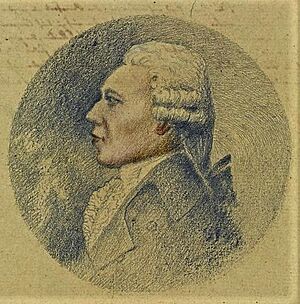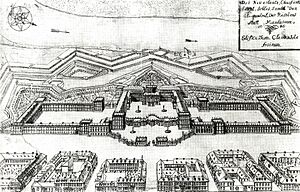Carl Stamitz facts for kids
Carl Philipp Stamitz (born May 8, 1745 – died November 9, 1801) was a German composer. He was also a talented violinist and viola player. Carl came from a family of musicians and was an important part of the Mannheim School of music. This was a famous group of composers and musicians in the 1700s.
Carl was the oldest son of Johann Stamitz, who was also a famous musician. Carl was born in Mannheim, Germany. He learned music from his father and later from Christian Cannabich, who took over his father's role in the Mannheim orchestra. When he was young, Carl played the violin in the court orchestra in Mannheim.
In 1770, Carl started traveling a lot. He was a virtuoso, meaning he was extremely skilled at playing his instruments. He performed in many European cities, living for a while in Strasbourg and London. He never found a permanent job, but he was always busy with concerts. In 1794, he stopped traveling and moved to Jena, Germany, with his family. He faced some financial difficulties in his later years and passed away in 1801.
Carl Stamitz wrote many different types of music. He composed over 50 symphonies, which are large pieces for an orchestra. He also wrote many concertos, which are pieces for a solo instrument (like a clarinet or violin) with an orchestra. Some of his concertos for the clarinet and viola are still very popular today. He also wrote duos, trios, and quartets for smaller groups of instruments.
His music sounds a bit like the music of Mozart or Haydn. It has lovely melodies that are easy to enjoy. The first parts of his orchestral pieces often follow a pattern called sonata form. These are usually followed by expressive, calm middle parts and lively final parts called rondos.
Contents
About Carl Stamitz
Early Life in Mannheim
Carl Stamitz was born in Mannheim and was baptized on May 8, 1745. He was the oldest son of Johann Stamitz, a well-known violinist and composer. Johann Stamitz was the leader of the famous court orchestra at Mannheim Palace. He trained the orchestra to play with great skill and feeling. They were known for their ability to play both softly and loudly, creating a big impact.
Carl learned to play the violin and compose music from his father. After his father died in 1757, when Carl was 12, he continued his lessons. His teachers included Christian Cannabich, who became the new leader of the Mannheim orchestra. Other important composers like Ignaz Holzbauer and Franz Xaver Richter also helped with Carl's musical education.
Traveling Musician
By the time Carl was 17, he was playing the violin in the court orchestra. In 1770, he decided to leave his job and start traveling. He became a famous virtuoso, playing the violin, viola, and viola d'amore. He often took short jobs performing in different cities. Even though he was very talented, he never found a permanent job with a royal family or a big orchestra.
In 1770, he went to Paris, France. There, he worked for Louis de Noailles, a duke, who made him his court composer. Carl also performed in popular concerts called Concerts Spirituels. Sometimes, his brother Anton Stamitz joined him. From Paris, Carl traveled a lot. He performed in German cities like Frankfurt and Augsburg. In 1775, he even went as far as Saint Petersburg in Russia.
Later, he spent time in Strasbourg and had great success in London in 1777 and 1778. Many other German musicians also found success in London. Between 1782 and 1783, Carl gave concerts in The Hague and Amsterdam. In 1785, he returned to Germany, performing in cities like Hamburg and Leipzig. In 1786, he helped perform Handel's famous work, Messiah, in Berlin.
Carl continued to travel, visiting Dresden, Prague, and Nuremberg. In Nuremberg, in 1787, he put on a special musical event to celebrate the balloon flight of Jean-Pierre Blanchard, a French aviation pioneer. He later directed concerts in Kassel. By this time, Carl was married and had four young children. He had to keep traveling to support his family.
In 1792, he gave a concert in Weimar. The famous writer Goethe was in charge of the theater there. In 1793, Carl made one last trip along the River Rhine to his hometown of Mannheim. After that, he stopped traveling. Around 1794 or 1795, he moved his family to Jena, a university town in central Germany.
Later Years
In Jena, there wasn't a big music scene or orchestra. Carl faced some financial difficulties during these years. He passed away in November 1801.
Carl Stamitz's Music
Carl Stamitz wrote over 50 symphonies and at least 38 symphonies concertantes. He also composed more than 60 concertos for many instruments. These included the violin, viola, viola d'amore, cello, clarinet, basset horn, flute, and bassoon. He also wrote a lot of chamber music, which is music for small groups of instruments. His clarinet and viola concertos are especially well-known and loved from that time.
When he lived in Paris, Carl worked with a talented clarinet player named Joseph Beer. They even wrote one of Carl's clarinet concertos together. Carl Stamitz was also the first composer to use a special playing technique called left-hand pizzicato in a piece of music. This is where the musician plucks the string with their left hand.
Carl wrote his cello concertos for Frederick William II of Prussia. This king was a very good amateur musician. Even famous composers like Mozart and Beethoven wrote music for him!
Musical Style
Carl Stamitz's music sounds similar to the early works of Mozart or the middle period of Haydn. His pieces have clear, appealing melodies. The different instrument parts often move together in a pleasing way. He wrote music that showed off the solo instruments, but it wasn't overly difficult to play.
The first parts of his concertos and orchestral works usually follow a structure called sonata form. The middle parts are often expressive and calm, sometimes called a 'Romance'. The final parts are usually lively rondos, which means a main musical idea keeps coming back.
Like his teacher Franz Xaver Richter, Carl Stamitz often used minor keys in his music. He also liked to use a variety of different keys, sometimes even unusual ones.
Selected Works
Symphonies
- 50 symphonies (usually with three parts, without a minuet)
Concertos
- 11 clarinet concertos (at least one written with Joseph Beer)
- 3 cello concertos
- 40 concertos for flute, bassoon, basset horn, violin, viola, viola d'amore, and combinations of these instruments
- Viola concerto no. 1 in D major
- 38 symphonies concertantes
Chamber Music
- Duos, trios, quartets for various instruments, often strings. His duos for violin and viola are very special.
- 6 orchestral quartets, op.1
- 6 orchestral quartets, op.14
Operas Both of these operas are now lost.
- Der verliebte Vormund (1787)
- Dardanus (1780)
Selected Recordings
- Symfonies concertante, Vienna Symphony, Henry Swoboda, conductor, 1950.
- Four Quartets for Winds and Strings, Nonesuch Records, c. 1966.
- Chamber music. Selections, Musical Heritage Society, 1972.
- Cello Concertos Christian Benda with the Prague Chamber Orchestra, Naxos 8.550865, 1994.
- Carl Stamitz: Four Symphonies, London Mozart Players, Matthias Bamert, conductor, Chandos Records, 1995.
- Carl Stamitz: Clarinet Concertos, Sabine Meyer, Academy of St. Martin in the Fields, Iona Brown, conductor, EMI Classics, 1993.
See also
 In Spanish: Carl Stamitz para niños
In Spanish: Carl Stamitz para niños



